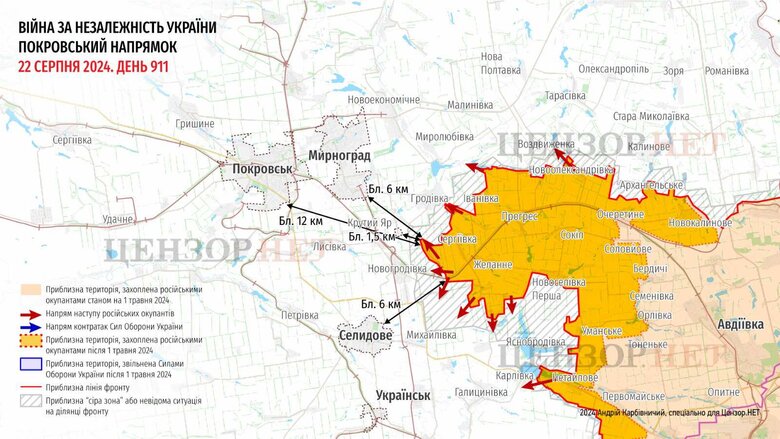How to save Pokrovsk when enemy is 8 km away?
I am in contact with all our brigades in this area. In total, our aerial reconnaissance spots 250 to 500 enemy infantrymen on the frontline and in the immediate rear on a front up to 18 km wide. Some of them are moving forward, some are moving back, some are entrenched.
That is, the enemy does not send tank columns into battle, does not assault with companies, and the superiority in numbers does not have multiple values.
The enemy's tactic is combat reconnaissance in small groups of 3-6 people, in several directions, under drone control, combined with the destruction of our positions with drones and artillery. The Russians suffer significant losses, but in some places they flow between our combat formations, in others our troops retreat after eliminating several assault groups, in others our troops retreat due to control problems, and the enemy quickly takes over empty positions. Because the Russians have several echelons of combat formations in the offensive (and are shot on the spot for refusing to attack), and we have combat formations of one echelon, and therefore every opponent can be pushed through. The only way to stop the enemy with losses is to equip the defensive line and stop exchanging in counter-battles in unequipped landings.

Dynamics of the Russian Armed Forces' Offensive on the Pokrovsk Agglomeration
To make such an exchange unprofitable for the enemy, so that the enemy's losses become 5-10 times higher, to knock out the infantry, you need organisation and planning in defence, decentralised actions, interaction between troops with maximum use of drones and electronic warfare, equipped positions, cleared sectors for fire and destruction, and, most importantly, your own combat-ready infantry, which does not retreat not because it is immortal, but because it is well trained, managed, trusts its commanders and has replacements for rotation and support.
In order to effectively use drones and electronic warfare, they need to be subordinated to a single centre, and this interaction needs to actually start working, so that our electronic warfare stops shooting down our own drones.
To immediately deploy hundreds of mavics and outposts to each brigade in order to stop the enemy by increasing the number of attacks. Supplies from the state are scarce and do not cover 10% of the needs.
Since the OTG command cannot and will not be able to organise adequate management and use at the operational and tactical level, someone must partially take over the functions of the OTG in the direction, just as it was very successfully done, for example, by the 58th Infantry Brigade in another direction.
At least one combat-capable brigade should be deployed on the outskirts of Pokrovsk, which, given the enemy's advance of approximately 500 metres per day, will have no more than a week to deploy. We need one brigade with an effective headquarters that is able to establish on-the-ground interaction between all attached units, between drones and electronic warfare, between intelligence and weapons.
Pokrovsk is the only mine in Ukraine that is still producing coking coal. If we lose Pokrovsk, we will not only have to buy all our coking coal abroad, we will have to increase the load on our communications to bring in additional millions of tonnes from abroad. If the troops defending Pokrovsk receive funds from the state and the mine owner (Metinvest) for drones, electronic warfare, pick-up trucks and ATVs, then with one adequately organised brigade, the Russian offensive could be stopped.
This is as beneficial as possible for the state and defence forces.
Yurii Butusov, Censor. NET
